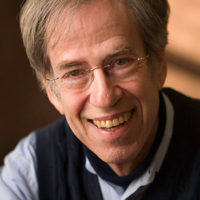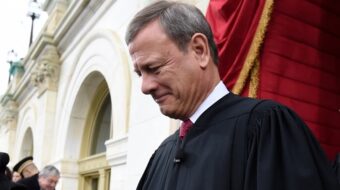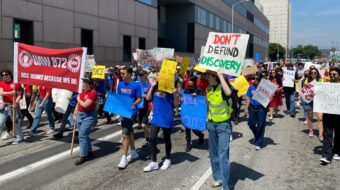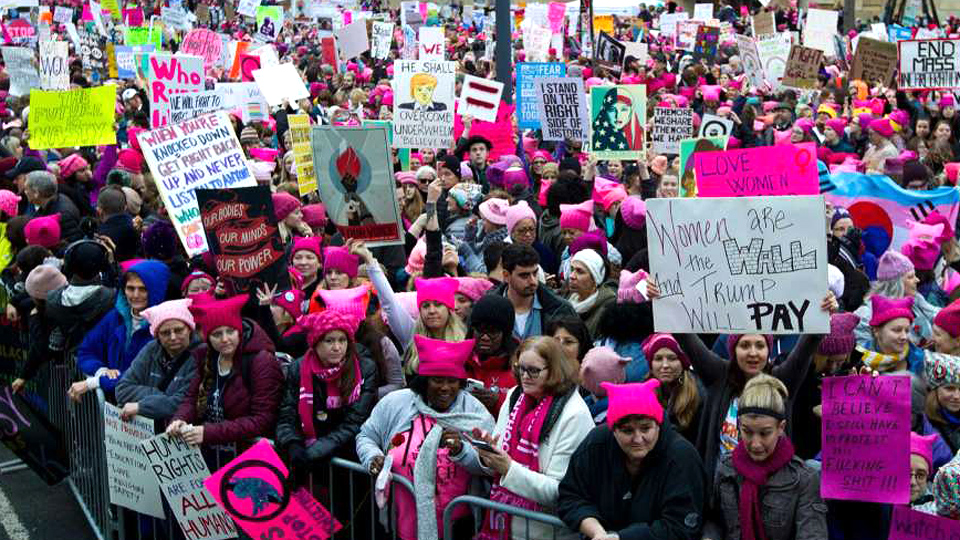
WASHINGTON – The streets and thoroughfares of every major American city were packed with hundreds of thousands today declaring their rejection of the dark message of hate and division that Donald J. Trump laid out yesterday after he was sworn in as the 45th U.S. president.
Here in the nation’s capital the crowds — police on the street told PW reporters could be upwards of 750,000 — were the largest most had seen in a lifetime. And as they clogged the major streets here additional hundreds of thousands did the same in New York, Atlanta, Boston, Chicago, Los Angeles, Denver, St. Paul and more than 600 other cities and towns from one end of America to the other.
Across the Atlantic huge crowds demonstrated against the Trump agenda in European capitals including Berlin and London.
The historic uprising across the nation and around the world dwarfed the celebrations yesterday of Trumps’ inauguration . Trump’s attempt to draw attention away from the historic protests against his agenda by staging an event at CIA headquarters failed to achieve its purpose. The meeting he held there was barely a sidebar to the coverage given to the demonstrations.
PW reporters calling their reports into Chicago were unable to move in the packed streets in Washington where the crowds were so huge that hundreds of thousands were unable to reach the originally planned route.
“I worked for Trump for many years in Atlantic City ,” one marcher who made the trip here from New Jersey said. “The mistreatment of women, all the things they said about Trump are true – sexual abuse, the whole thing, that’s why I’m here.”
A marcher from Lansing, Michigan said she organized a group of eight to join an anti-Trump website, Indivisible.com. “Within days we grew into a group of 100,” she said.
Another marcher said she hailed from upstate New York. “Already so many of my neighbors who voted for Trump said they were sorry they did so,” she said.
Police and national guardsmen in the massive and peaceful crowds here frequently waved to the demonstrators, sometimes cheering them on.
“We have Muslims, Jews, Christians, women, men, black, white and brown together here today all marching together,” said Randi Weingarten, president of the American Federation of Teachers. “They are far greater in passion and numbers than the hate and division we heard here yesterday,” she said, referring to Trump’s inaugural speech.
Thousands of union members, campaigners for worker rights, gay-lesbian-bisexual rights, immigrants’ rights, freedom from police brutality against African-Americans, veterans who protested wars and Muslim-Americans protesting discrimination all joined in to overwhelm the nation’s capital, dwarfing the 100,000 people Trump drew the day before.
Support of the causes, groups and individuals whom Trump vilified and scorned was a big theme of many marchers. But the several thousand unionists at the D.C. march, led by AFL-CIO Secretary-Treasurer Liz Shuler, emphasized a more positive attitude. That attitude carries an edge, though.
“This is so inspiring, especially after yesterday” – Trump’s inaugural—Shuler said before addressing the labor marchers in their own pre-march rally in a D.C. park.
“We’re here not only to march, but we’re here to build a movement,” Shuler told the crowd, via bullhorn. “It’s a movement for paid family leave. It’s a movement for equal rights. It’s a movement for workers’ rights. It’s a movement for immigrants’ rights. “We’re going to march together and stand together in solidarity to make sure our voices are heard,” she declared.
Labor’s edgier message came from other participants and from its individual jacket stickers and signs. One sign and sticker read: “Will strike if provoked!’ with the word “strike” in white inside a red box, followed by “The Union makes us strong.” The back of the same sign read: “Women union strong and ready to fight.”
The D.C. march drew members of the Coalition of Labor Union Women, the Teachers, the Steelworkers, the Office and Professional Employees, AFSCME District Council 24, the Mine Workers, the Food and Commercial Workers, IATSE, the Electrical Workers, the Professional and Technical Employees, Pride at Work and the Auto Workers, among others.
The marches in other cities, including New York, London and Berlin, drew hundreds of thousands of people more. Some highlights included:
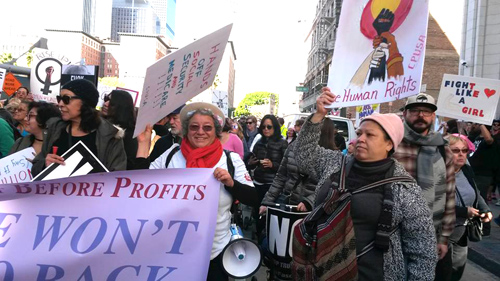
- Some 100,000 people showed up in Los Angeles at 9 am Pacific Time – coincident with the height of the D.C. march, but two hours before L.A. labor’s protest was scheduled to kick off. “We will not stand for hate and division,” the L.A. County Federation of Labor said.
“We want to be respected. We deserve an economy that works for all, a political system that is transparent and representative, an energy system that is sustainable for the long term, media which can be trusted to provide real and honest information, justice for oppressed communities, and a united society,” the L.A. Fed added.
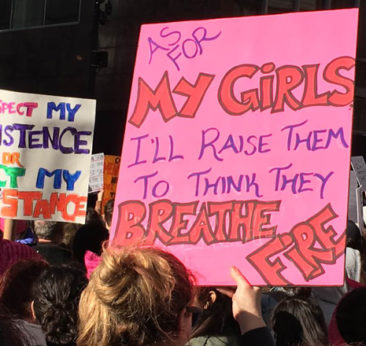
- Some 250,000 people rallied in Chicago’s Grant Park, a crowd so large that organizers had to call off a planned march from there through the Loop – which didn’t stop thousands from doing so anyway.
The Chicago L added trains and cars to its daily service, while D.C.’s Metro system was overwhelmed – so much so that officials threw open the gates in at least one station close to the march, Judiciary Square. The farthest station, 30 miles out in the suburbs, had lines going up its escalators out to the surface and the length of its large parking lot.
- Home Depot workers in the Twin Cities, Minnesota, not only marched, but struck. Calling themselves the first workers to strike during the Trump administration, they walked out the morning of Jan. 21. The key causes were low pay and lack of respect for the mostly Latina workforce. They pledged “a new resistance” to Trump and corporate capital.
“Now is not the time to be scared or to stay home,” Veronica Mendez Moore, co-director of CTUL, Centro de Trabajadores Unidos en Lucha/Center of Workers United in Struggle, told Barb Kucera of Workday Minnesota. “Now is the time to fight. Now is the time for the resistance.”
“This is about corporate power,” said Nick Faber, vice president of St. Paul Federation of Teachers Local 28, one of many union leaders to join the protest there. “When workers don’t earn enough, it’s difficult for them to play a role in their children’s education, he said, and the entire community suffers.”
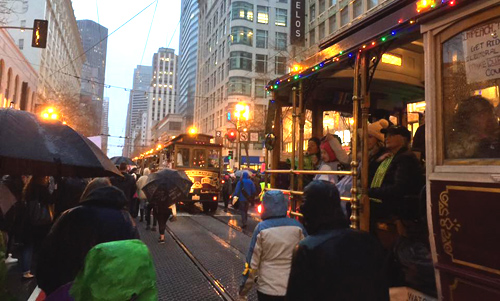
- The San Francisco protest for women’s rights and workers’ rights targeted Trump’s nominee for Labor Secretary, fast-food kingpin Andrew Puzder and his policies and actions. His Hardee’s and Carl’s Jr. chains are known for their low wages, job safety violations and sexual harassment. The San Francisco protest started at a Carl’s Jr., then headed downtown.
“The person whose business we are outside of is the person who has been nominated as the Secretary of Labor. He hates the minimum wage, he hates labor unions and he hates the fact that workers actually have rights,” Tim Paulson, executive director of the San Francisco Labor Council, told local broadcasters.
“We’re going to fight for civil rights, were going to fight for women’s rights, and were going to fight for the right to have representation in the workplace,” he added.
In D.C., individual participants anticipated a long and continuing battle for women’s’ rights, workers’ rights and other causes, against Trump and the GOP.
“Trump would like to break the union system, so we’re standing strong to combat that for the next four years,” said Barbara Churchill, Treasurer of Theatrical and Stage Employees Local 868 in the D.C. suburbs.
“I’m so excited to be here, amongst my sisters and brothers, standing for justice, not just justice for women, but for all human beings,” said Joan Hill, a Steelworker from Pittsburgh.
“Everything he stands for pushes us back 100 years. That’s ridiculous,” Yvonne Rojo of City of Commerce, Calif., a Los Angeles suburb said. “Let them see the number of people,” added Rojo, an IBEW Local 11 member who flew into D.C. the day before. “I think this kind of speaks for itself – how many people didn’t vote him into office.”
“We want equality for all. Progress cannot be made and America will not be strong if half of us are held back,” said Maryse Crevecoeur, a United Federation of Teachers member from New York, who teaches at PS 6 in Brooklyn. UFT chartered three buses for its members. Its members sung labor’s anthem, Solidarity Forever, during the march.
Washington (D.C.) Teachers Union member Nancy Nickel, a second grade teacher, added that GOP policies would “hurt small kids in our public schools.”
Another marcher, a special education administrator from Pittsburgh, held a sign reading “I have an I.D.E.A.: Say ‘No’ to DeVos,” referring to the Individuals with Disabilities Education Act and Trump’s nominee to head the Education Department, Michigan millionaire – and strident public school foe – Betsy DeVos.
“I’m not in the union,” the administrator, who declined to give her name, explained. “But I support them 100 percent, because with no unions, I have no teachers.”
“My students understand what unions have done. They’re the reason we don’t have another Triangle Shirtwaist fire,” said high school history teacher Anna Koloseike of Asheville, N.C., which she called “a blue spot in a red state.” The fire killed 146 working girls in New York City’s garment district in 1911, and led to building fire safety codes and other reforms.
“I came down to show solidarity with my sisters and brothers in the U.S.,” said Sandra Banman, a middle school teacher from Toronto and one member of four busloads of marchers who detoured from the main rally to show up in front of the Canadian Embassy.
“The fact that education is now being labeled elitist is crazy,” she added. “This is liberating. It forces us to be more democratic.”
Signs – especially the hand-made or home-made signs—said much the same thing, for unions and against looming anti-worker, anti-woman, anti-immigrant Republican policies.
“Public education is a human right,” read one sign held by an UFT member.
“It’s the ‘U’ and ‘I’ in union that makes us strong,” the banner from the Carpenters’ local in D.C. added. “United we stand, divided we fall, “ said the leader of that group, from Local 177. “Equality hurts no one,” read another sign, carried by a Sheet Metal Worker.
“Trump: Racist, sexist, elitist, homophobic, xenophobic,” read a handmade sign by Dori Strickland, a communications professional, currently unemployed, from Chicago’s North Side. “I need a billboard, not just a sign,” she said. “There are too many problems” with Trump.
Eric Halter, of the Democratic Socialists, was one of several people sporting one-word signs: “Ugh!”
Many marchers made it clear they are campaigning not just for themselves, but for the future. Dozens pushed babies in strollers. Two 15-year-old high schoolers from Towson, Md., held signs that read “Beware! Next time I’ll be voting!” and “Dear World: We are not all idiots.”
And Rosie Poling of Naples, Fla., carried a sign that read: “Today I turn 18. Tomorrow, I work for equality.” Jan. 21 is her birthday.
John Wojcik contributed to this article.



